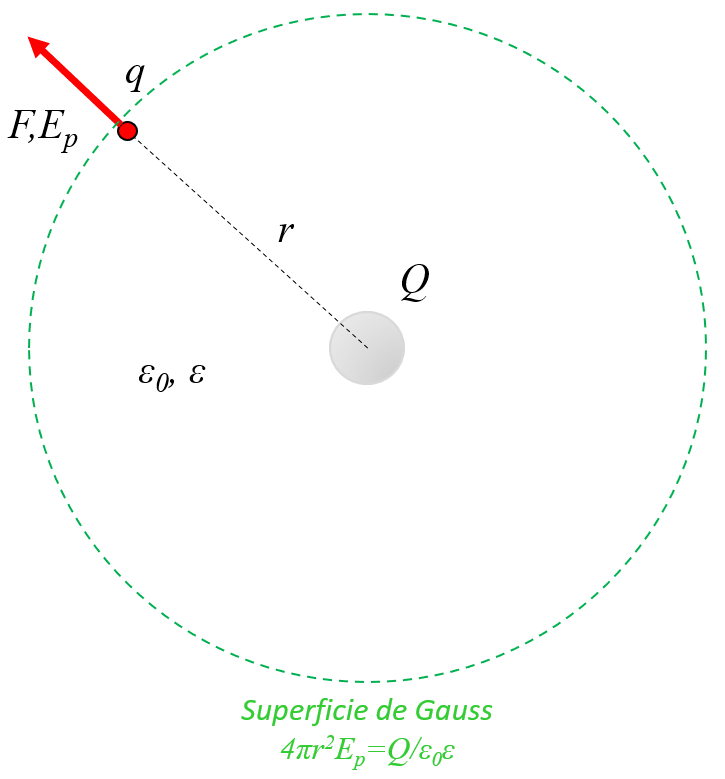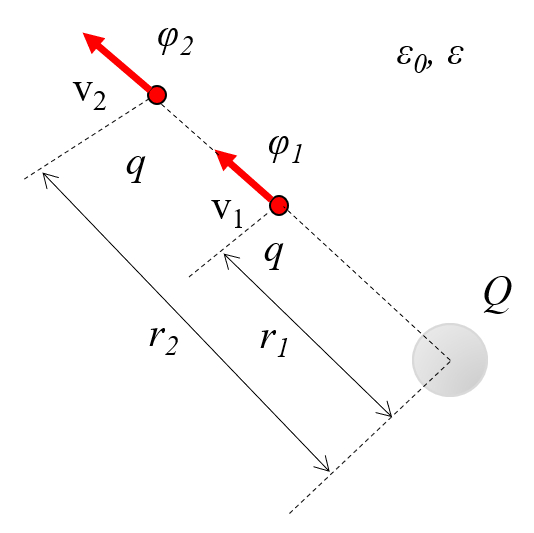Point charge
Storyboard 
A point charge is an idealized model in physics where a charge is concentrated at a single point with no dimensions. It generates an electric field that radiates uniformly outward, decreasing in strength with the square of the distance.
ID:(2074, 0)
Point charge
Storyboard 
A point charge is an idealized model in physics where a charge is concentrated at a single point with no dimensions. It generates an electric field that radiates uniformly outward, decreasing in strength with the square of the distance.
Variables
Calculations
Calculations
Equations
In the case of a spherical Gaussian surface, the electric field ($\vec{E}$) is constant in the direction of the versor normal to the section ($\hat{n}$). Therefore, using the charge ($Q$), the electric field constant ($\epsilon_0$), and the dielectric constant ($\epsilon$), it can be calculated by integrating over the surface where the electric field is constant ($dS$):
with the surface ($S$) for a sphere of radius a distance between charges ($r$):
Thus, the electric field of a point charge ($E_p$) results in:
In the case of a spherical Gaussian surface, the electric field ($\vec{E}$) is constant in the direction of the versor normal to the section ($\hat{n}$). Therefore, using the charge ($Q$), the electric field constant ($\epsilon_0$), and the dielectric constant ($\epsilon$), it can be calculated by integrating over the surface where the electric field is constant ($dS$):
with the surface ($S$) for a sphere of radius a distance between charges ($r$):
Thus, the electric field of a point charge ($E_p$) results in:
The electric potential, point charge ($\varphi_p$) is calculated from the radial integration of the electric field of a point charge ($E_p$) from the radius ($r$) to infinity, which results in
On the other hand, for the charge ($Q$), the dielectric constant ($\epsilon$), and the electric field constant ($\epsilon_0$), the value of the electric field of a point charge ($E_p$) is
This implies that by integrating
$\varphi_p = -\displaystyle\int_{r}^{\infty} du \displaystyle\frac{ Q }{4 \pi \epsilon_0 \epsilon u^2 }= -\displaystyle\frac{ Q }{ 4 \pi \epsilon_0 \epsilon }\displaystyle\frac{1}{ r }$
we obtain
The electric potential, point charge ($\varphi_p$) is calculated from the radial integration of the electric field of a point charge ($E_p$) from the radius ($r$) to infinity, which results in
On the other hand, for the charge ($Q$), the dielectric constant ($\epsilon$), and the electric field constant ($\epsilon_0$), the value of the electric field of a point charge ($E_p$) is
This implies that by integrating
$\varphi_p = -\displaystyle\int_{r}^{\infty} du \displaystyle\frac{ Q }{4 \pi \epsilon_0 \epsilon u^2 }= -\displaystyle\frac{ Q }{ 4 \pi \epsilon_0 \epsilon }\displaystyle\frac{1}{ r }$
we obtain
Examples
In the case of a spherical Gaussian surface, the electric field ($\vec{E}$) is constant in the direction of the versor normal to the section ($\hat{n}$). Therefore, using the charge ($Q$), the electric field constant ($\epsilon_0$), and the dielectric constant ($\epsilon$), it can be calculated by integrating over the surface where the electric field is constant ($dS$):
with the surface ($S$) for a sphere of radius a distance between charges ($r$):
Thus, the electric field of a point charge ($E_p$) results in:
The electric potential, point charge ($\varphi_p$) is calculated from the radial integration of the electric field of a point charge ($E_p$) from the radius ($r$) to infinity, which results in
On the other hand, for the charge ($Q$), the dielectric constant ($\epsilon$), and the electric field constant ($\epsilon_0$), the value of the electric field of a point charge ($E_p$) is
This implies that by integrating
$\varphi_p = -\displaystyle\int_{r}^{\infty} du \displaystyle\frac{ Q }{4 \pi \epsilon_0 \epsilon u^2 }= -\displaystyle\frac{ Q }{ 4 \pi \epsilon_0 \epsilon }\displaystyle\frac{1}{ r }$
we obtain
As illustrated in the following graph:
the field at two points must have the same energy. Therefore, the variables the charge ($Q$), the particle mass ($m$), the speed 1 ($v_1$), the speed 2 ($v_2$), and the electric potential 1 ($\varphi_1$) according to the equation:
and the electric potential 2 ($\varphi_2$), according to the equation:
must satisfy the following relationship:
The electric field of a point charge ($E_p$) is a function of the charge ($Q$), the electric field constant ($\epsilon_0$), the dielectric constant ($\epsilon$), and the distance between charges ($r$) and is calculated as follows:
The electric field of a point charge ($E_p$) is a function of the charge ($Q$), the electric field constant ($\epsilon_0$), the dielectric constant ($\epsilon$), and the distance between charges ($r$) and is calculated as follows:
The electric potential, point charge ($\varphi_p$) is with the charge ($Q$), the distance between charges ($r$), the dielectric constant ($\epsilon$) and the electric field constant ($\epsilon_0$) equal to:
The electric potential, point charge ($\varphi_p$) is with the charge ($Q$), the distance between charges ($r$), the dielectric constant ($\epsilon$) and the electric field constant ($\epsilon_0$) equal to:
Electric potentials, which represent potential energy per unit of charge, influence how the velocity of a particle varies. Consequently, due to the conservation of energy between two points, it follows that in the presence of variables the charge ($q$), the particle mass ($m$), the speed 1 ($v_1$), the speed 2 ($v_2$), the electric potential 1 ($\varphi_1$), and the electric potential 2 ($\varphi_2$), the following relationship must be satisfied:
ID:(2074, 0)


